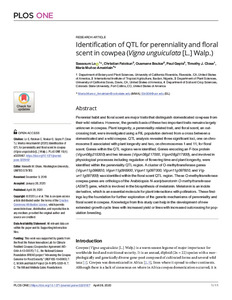| dc.contributor.author | Lo, S. |
| dc.contributor.author | Fatokun, C. |
| dc.contributor.author | Boukar, O. |
| dc.contributor.author | Gepts, P. |
| dc.contributor.author | Close, T.J. |
| dc.contributor.author | Muñoz-Amatriaín, M. |
| dc.date.accessioned | 2022-08-10T13:03:30Z |
| dc.date.available | 2022-08-10T13:03:30Z |
| dc.date.issued | 2020-04-28 |
| dc.identifier.citation | Lo, S., Fatokun, C., Boukar, O., Gepts, P., Close, T.J. & Muñoz-Amatriaín, M. (2020). Identification of QTL for perenniality and floral scent in cowpea (Vigna unguiculata [L.] Walp.). PloS one, 15(4), e0229167: 1-11. |
| dc.identifier.issn | 1932-6203 |
| dc.identifier.uri | https://hdl.handle.net/20.500.12478/7630 |
| dc.description.abstract | Perennial habit and floral scent are major traits that distinguish domesticated cowpeas from their wild relatives. However, the genetic basis of these two important traits remains largely unknown in cowpea. Plant longevity, a perenniality-related trait, and floral scent, an outcrossing trait, were investigated using a RIL population derived from a cross between a domesticated and a wild cowpea. QTL analysis revealed three significant loci, one on chromosome 8 associated with plant longevity and two, on chromosomes 1 and 11, for floral scent. Genes within the QTL regions were identified. Genes encoding an F-box protein (Vigun08g215300) and two kinases (Vigun08g217000, Vigun08g217800), and involved in physiological processes including regulation of flowering time and plant longevity, were identified within the perenniality QTL region. A cluster of O-methyltransferase genes (Vigun11g096800, Vigun11g096900, Vigun11g097000, Vigun11g097600, and Vigun11g097800) was identified within the floral scent QTL region. These O-methyltransferase cowpea genes are orthologs of the Arabidopsis N-acetylserotonin O-methyltransferase (ASMT) gene, which is involved in the biosynthesis of melatonin. Melatonin is an indole derivative, which is an essential molecule for plant interactions with pollinators. These findings lay the foundation for further exploration of the genetic mechanisms of perenniality and floral scent in cowpea. Knowledge from this study can help in the development of new extended-growth cycle lines with increased yield or lines with increased outcrossing for population breeding. |
| dc.description.sponsorship | Feed the Future Innovation Lab for Climate Resilient Cowpea |
| dc.description.sponsorship | National Science Foundation BREAD |
| dc.description.sponsorship | Bill & Melinda Gates Foundation |
| dc.format.extent | 1-11 |
| dc.language.iso | en |
| dc.subject | Cowpeas |
| dc.subject | Vigna Unguiculata |
| dc.subject | Quantitative Trait Loci |
| dc.subject | West Africa |
| dc.title | Identification of QTL for perenniality and floral scent in cowpea (Vigna unguiculata [L.] Walp.) |
| dc.type | Journal Article |
| cg.contributor.crp | Grain Legumes |
| cg.contributor.affiliation | University of California |
| cg.contributor.affiliation | International Institute of Tropical Agriculture |
| cg.contributor.affiliation | Colorado State University |
| cg.coverage.region | Africa |
| cg.coverage.region | West Africa |
| cg.coverage.country | Nigeria |
| cg.coverage.hub | Headquarters and Western Africa Hub |
| cg.researchtheme | Biotech and Plant Breeding |
| cg.identifier.bibtexciteid | LO:2020 |
| cg.isijournal | ISI Journal |
| cg.authorship.types | CGIAR and advanced research institute |
| cg.iitasubject | Agronomy |
| cg.iitasubject | Cowpea |
| cg.iitasubject | Grain Legumes |
| cg.iitasubject | Plant Breeding |
| cg.iitasubject | Plant Health |
| cg.iitasubject | Plant Production |
| cg.journal | PLOS ONE |
| cg.notes | Published online: 28 April 2020 |
| cg.accessibilitystatus | Open Access |
| cg.reviewstatus | Peer Review |
| cg.usagerightslicense | Creative Commons Attribution 4.0 (CC BY 0.0) |
| cg.targetaudience | Scientists |
| cg.identifier.doi | https://dx.doi.org/10.1371/journal.pone.0229167 |
| cg.iitaauthor.identifier | Christian Fatokun: 0000-0002-8428-7939 |
| cg.futureupdate.required | No |
| cg.identifier.issue | 4 |
| cg.identifier.volume | 15 |

